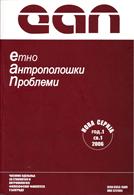Vampir: osujećeni mitski predak i simbol osujećenog muškog seksualnog potencijala
The vampire: Thwarted mythical ancestor and symbol of the thwarted male sexual potential
Author(s): Lidija RadulovićSubject(s): Gender Studies, Customs / Folklore, Cultural Anthropology / Ethnology, Eastern Orthodoxy
Published by: Филозофски факултет, Универзитет у Београду
Keywords: gender / sex; sexuality; masculinity; vampire; mythical ancestor;
Summary/Abstract: Ethnographic literature from the late eighteenth and during the course of nineteenth and twentieth century, presents us with a diverse but insufficiently conceptualized notions based on which vampire could be discussed in the context of aberrant life, untypical death, or inadequate burial practice. The structure of ancestral cult, containing among other things ideas of the "nature" of interrelationships between the living and the dead, is only one of the constructions imitating the ideological discourse of old-fashioned cultural pattern, certain relations in the society and structural order. Relations between the living and the dead are limited to ones on the male side, implying the reciprocal obligation: on one hand, respect of the burial rituals and mourning determine the "posthumous destiny", as well as the obligation of sacrificial offerings to godly ancestors, on the other the requirement of ancestors to protect and watch over their descendants in return. In order to be able to reproduce at all a community must mind the deceased’s soul, i.e. prevent the possible demonization by properly observing the rituals. In that sense, notions of vampires and the devil are emblematic warnings of the fact that each deceased, necessarily, is not an ancestor, and that the ideal model of generational hierarchy and of awe sustained by the proclaimed old-fashioned relations is actually relative, that is to say the notions of vampires and the devil point to the split in generations and to the governing relations in an old-fashioned society. Directly dependant on the male descendents, aberrant life as well as the aberrant "posthumous destiny" are mechanisms for excluding from the social relations with the dead the ones that cannot be given the status of ancestors, so we can conceive them as thwarted mythical ancestors. In the second part of the paper, I endeavored to demonstrate that the conceptions of masculinity could also be deconstructed through analysis of mythical imagery, for mythological images of say vampires are based on contradictions between objectively different scripts – religious and secular ones. Images of vampires could as well be viewed as symbolic constructions of certain masculinity patterns, first of all church, non-Christian (pagan) and secular patterns that collide. The collision of different masculine scripts results in repression of those not belonging to public Orthodox discourse, so the latent processes of Christianization implicitly reproduced the notions of vampire as thwarted male sexual potential.
Journal: Етноантрополошки проблеми
- Issue Year: 1/2006
- Issue No: 1
- Page Range: 181-202
- Page Count: 22
- Language: Serbian

